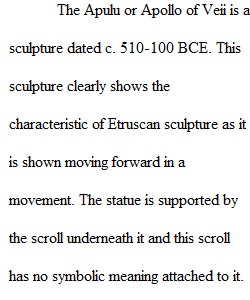


Q Comparing and contrasting works of art is part of art history. It helps to focus on a piece and gain a greater understanding of it. Look at the Apulu (Apollo of Veii) sculpture (in the Powerpoint and in the text) and compare it to a sculpture of your choosing from Ancient Greece. Stylistically, what is similar about the two sculptures? What is different? Are they made of the same medium? Are they compositionally similar? What are the major differences in composition? Were they used in similar contexts? (for example in temples, as decorative pieces, etc.)
View Related Questions